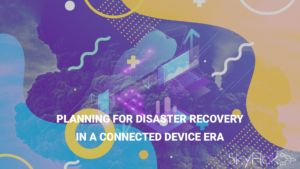March 31st is World Backup Day, and as the organizers recommend, no one should be a fool the next day (April 1) by not backing up and protecting their data.
Storage and backup is a necessity whether it’s a key part of your business or not. A large number of organizations have their key data in places where they don’t have control over it. Many users regularly backup their files to their computer hard drive or to another separate device. However, these methods are as secure as the computer or the device you are backing up to. Here at SkyFlok we recommend a more effective and safe method of securing your valuable files – online backup. Having an online backup means you can get your files quickly and easily restored to your computer from a secure online server.
Losing important files can be critical for your business and that is why it is important to make sure that the data backup you choose provides an effective and efficient data-recovery plan to get you back up and running as quickly as possible.
Leaders of several data storage and IT security companies were asked for their thoughts and recommendations on the World Backup Day.
Education and awareness is a constant need
Craig Hinkley, WhiteHat Security CEO, cites the need for a backup strategy and awareness based on research by Ponemon in 2017 that shows the average total cost of a data breach reaching $3.62 million, with a 27.7 percent chance of a recurring material data breach over the next two years. With the overload of data being created by devices and apps, he expects these numbers will soar over the next few years, begging the question: What can companies do to secure their digital business?
“They can proactively address the security challenge, and World Backup Day can be the perfect reminder for individuals and businesses to secure the applications that are the lifeblood of their business: back-up, patch-up and remediate vulnerabilities,” Hinkley said. “To address this challenge, however, we need to encourage security education across all teams responsible for developing and maintaining secure apps. It’s on us-security vendors-to help organizations bridge the divide between the security and development teams.”
Poor planning leads to failed Internet connections
Experts agree on the importance of a backup plan that extends beyond simple data protection to network connectivity that ensures the Internet is always on.
“We all appreciate the importance of backing up our data, but a backup plan for the network is usually given less thought. The question is not whether your business will lose Internet connectivity, it’s when,” said Ken Hosac, vice president of IoT strategy and business development Cradlepoint. “In some areas Internet connectivity can experience service disruption up to several times a month, which exposes businesses to risks of lost revenue, reduced productivity and customer experience issues.”
While some companies counter this risk with a wired connection, Hosac suggests a wireless WAN failover, which is less expensive and easier to deploy.
Updates and maintenance should never stop
WhereScape CTO Neil Barton stresses the importance of continued maintenance.
“Undoubtedly, data protection is a growing challenge for IT teams, and on World Backup Day, it is important to remember that organizations should not only have a backup strategy, but also test it regularly to determine if data will be easily recoverable and accessible when needed,” Barton said. “It is no secret that data loss can have devastating effects on a company’s brand reputation and customer trust, making the ability to recover data quickly after a disaster critical to business survival.”
Alternative archiving and cloud DR solutions
Data backups cover a broad range of solutions today from cloud to old fashion tape. The options are many.
“In 2018 backup and data recovery is critical, and it’s not enough for it to simply, well, backup,” said Gary Watson, CTO and founder, Nexsan. “Evolved options like archive storage solutions can help eliminate data loss as well as provide added layers of security from tampering, corruption and ransomware – business necessities in today’s threat landscape. Archive storage can also help drive cost and performance benefits by allowing for greater long-term retention of data. A fully comprehensive data backup strategy should include business continuity, data protection and enhanced security features on top of fast and efficient storage.”
Matt VanderZwaag, director of product development at US Signal, says it’s surprising that with an estimated 1.8 zettabytes of data generated per year, only four in 10 companies have a fully documented disaster recovery plan in place. For them, a cloud solution might be the answer.
“On World Backup Day, we are all reminded of the importance of implementing a disaster recovery and backup strategy that is secure, compliant and scalable to respond to challenging data protection demands,” VanderZwaag said. “DRaaS solutions also use scalable infrastructure, allowing virtual access of assets with little or no hardware and software expenditures.”
Keeping a boundary between backup and primary data
Jason Collier, co-founder at Scale Computing, says backing up business critical data is more complex than many people realize, which may be why backup and disaster recovery plans fall apart in the hour of need.
“World Backup Day is an important reminder of this reality, and many fall short with a few common missteps,” Collier said. “The closer your backup is to the primary data, the more likely it is to suffer the same fate as your primary data. Additionally, performing backups as frequently as possible often falls by the wayside of priorities, but this is a very effective way to prevent data loss.”
Collier says that while emphasis is frequently placed on the recovery point of when the last backup was executed, recovery time is just as important. The bottom line, he stresses, is that we all need to take time to review backup plans and find out if we need to be doing more to prevent the next data loss event lurking around the corner.
The importance of diversifying budgets
When planning for the year, it’s not uncommon for organizations to focus on their spending on the datacenter alone. X-IO Storage CEO Bill Miller suggests budgets also be saved for backup solutions.
“World Backup Day is a good time to remember to not overlook backup and disaster recovery plans as you budget for your primary datacenter,” Miller said. “All flash is becoming a commoditized market and prices are dropping, so there’s no need to overspend in this area. The deals are out there, but organizations will have to work harder than ever to know if they’re truly getting the best deal for the long run on primary storage, which can ultimately free up funds for backup and support solutions.”
Eliminating the risk of new technologies
As companies budget and plan for the rollout of new technologies, it’s important to ensure they don’t create disruptions that result in data loss. The convergence of these factors will require businesses to look outside traditional backup capabilities and develop an IT resilience strategy that’s up to the many challenges of digital transformation.
“To deliver an always-on customer experience, especially while undergoing major changes to an infrastructure, businesses need to ensure they have a modern, risk-free platform in place, that utilizes continuous data protection combined with the ability to orchestrate and automate the mobility of applications to the ideal infrastructure,” said Rob Strechay, Zerto product senior vice president. “When these capabilities come together, businesses will have an IT resilience strategy to protect their infrastructure and reputation, and also enable innovation and transformation.”
Click here to view original web page at vmblog.com







